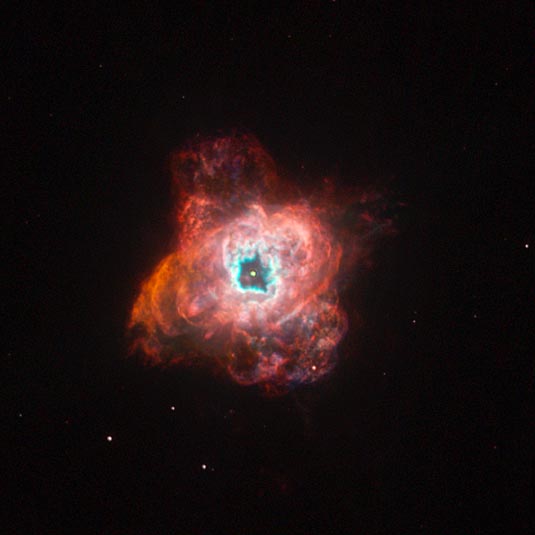
Description: Planetary nebula
Position (J2000); RA 13h 53m 57.00s Dec -66° 30' 50.00"
Constellation: Circinus
Distance: 7,000 light-years (2.14 kpc)
Visual Magnitude: 11.5
Apparent Dimensions: 6 arc-sec
Instrument: WFPC2
Exposure Date(s): February, 2007
Image Credit: NASA, ESA, and the Hubble Heritage Team (STScI/AURA)
Release Date: September 11, 2007
ABOUT THIS IMAGE:
The colorful, intricate shape of this NASA Hubble Space Telescope image reveals how the glowing gas ejected by dying Sun-like stars evolves dramatically over time.
This gaseous cloud, called a planetary nebula, is created when stars in the last stages of life cast off their outer layers of material into space. Ultraviolet light from the remnant star makes the material glow. Planetary nebulae last for only 10,000 years, a fleeting episode in the 10-billion-year lifespan of Sun-like stars.
The name planetary nebula has nothing to do with planets. They got their name because their round shapes resembled planets when seen through the small telescopes of the eighteenth century.
Over thousands of years, the clouds of gas expand away and the nebulae become larger. Energetic ultraviolet light from the star penetrates more deeply into the gas, causing the hydrogen and oxygen to glow more prominently, as seen near the center of NGC 5315..
This planetary nebula imaged by the Hubble Space Telescope lies in our Milky Way Galaxy. It's distance from Earth is about 7,000 light-years. The snapshot was taken with Hubble's Wide Field Planetary Camera 2 in February 2007. Like snowflakes, planetary nebulae show a wide variety of shapes, indicative of the complex processes that occur at the end of stellar life.
NGC 5315 is a chaotic-looking nebula, revealing an x-shaped structure. This shape suggests that the star ejected material in two different outbursts in two distinct directions. Each outburst unleashed a pair of diametrically opposed outflows.
This flower-shaped nebula has an unusually chaotic appearance. The outer regions show a roughly X-shaped structure, suggesting that there may have been two preferred axes for the ejection from the central star. A stellar wind from the central star appears to have cleared out a cavity in the center. Further out from the star, there is a wide range of excitation of the gas, ranging from the hot regions (blue) near the central star to the cooler surrounding shell (red). NGC 5315 is located in the direction of the Southern constellation Circinus.
This
image is a composite of many separate exposures made by the WFPC2 instrument
on the Hubble Space Telescope. Three filters were used to sample narrow
wavelength ranges. The color results from assigning different hues (colors)
to each monochromatic image. In the Hubble images, the red, green, and
blue colors represent light emitted by nitrogen, hydrogen, and oxygen,
respectively.In this case, the assigned colors are:
F502N ([O III]) blue
oxygen
F656N (Halpha) green
hydrogen
F658N ([N II]) red
nitrogen